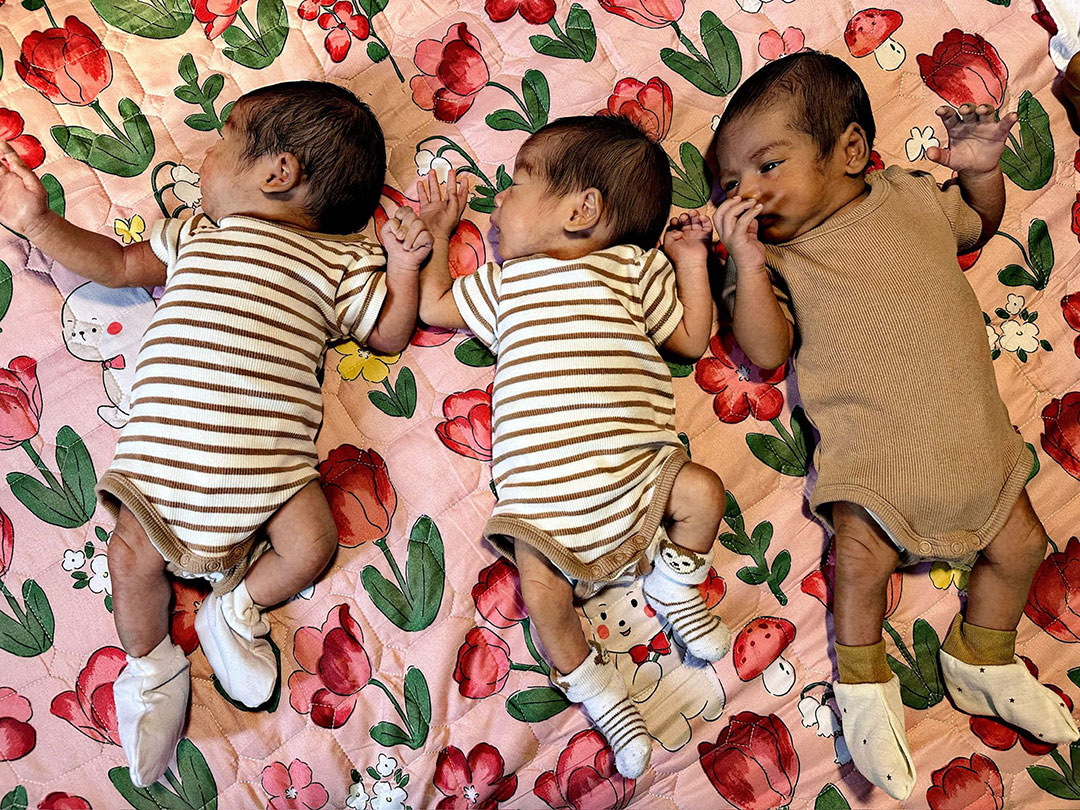One of the comments I frequently receive as a triplet mum is: “But you’re so small! How did you fit three babies inside at the same time?”
Indeed, a multiple pregnancy really tests you in many ways. Despite my small frame, my body managed to carry three babies for a relatively long gestation period. I’m incredibly grateful for the transformative feat it went through, although I relied on a wheelchair in the second half of my pregnancy. After delivering the children, my diastasis recti brought along some companions––lower back pain, an uncomfortable mummy tummy and at times, urine leaking when I sneezed or jumped. Life with young triplets was so busy and I endured it for three years before actively trying to heal my core.
If you’ve delivered multiples, such as twins or triplets, your chances of developing diastasis recti may be higher compared to women who have had a singleton pregnancy. Carrying multiple babies stretches the abdominal muscles to a greater extent, putting additional strain on the connective tissue. The increased pressure and stretching can lead to a greater likelihood of developing diastasis recti. However, not all women who give birth to multiples will experience this condition. Factors such as genetics, individual body composition, and how the pregnancy progresses play a role in determining the likelihood of developing diastasis recti.
What is Diastasis Recti:

Diastasis recti occurs when the connective tissue between the left and right rectus abdominis muscles, commonly known as the six-pack muscles, stretches and thins. This separation can lead to a bulging or doming of the abdominal area, weakness in the core, and potential lower back pain.
How do I know if I have Diastasis Recti:
To check for diastasis recti, lie on your back with knees bent, feet flat on the floor. Place your fingers a few inches above your belly button and gently lift your head and shoulders off the ground. If you feel a gap or softness between the muscles, it may indicate diastasis recti. It's advisable to consult with a healthcare professional for a proper diagnosis and guidance.
If indeed you have diastasis recti, here are some tips:
Embrace the Healing Process:
First things first, let's remind ourselves that healing takes time. Our bodies have gone through a lot, so it's essential to be patient and kind to ourselves. Taking care of twins, triplets and more, on top of other children for some of us, is no mean feat. On some days we might not even get to eat our lunch or take a shower, much less work on our body. Please remember to give yourself grace, especially on the tough days.
Prevent your Diastasis Recti from Worsening:
Try to steer clear of specific physical activities and exercises that could potentially exacerbate the condition. Avoid exercises like crunches, ab twists, planks, and yoga poses that put excessive strain on the abdominal area. Backward bends that stretch the midsection should also be avoided. Additionally, refrain from heavy lifting activities that can cause the stomach to bulge out. If you're unsure, a professional consultation is the best way to go.
Seek Professional Guidance:

Consider consulting with a physiotherapist or a postnatal fitness specialist who can assess your diastasis recti and guide you through a personalised exercise program. They can help ensure you're doing the right exercises in the correct form, maximising your healing potential. If you don’t have time for regular physical sessions, you can consider virtual consultations or courses.
Read also: A Physiotherapist's Guide to Postpartum Recovery
Start Gentle Core Strengthening:

When it comes to healing diastasis recti, gentle core exercises can work wonders. Start with exercises that engage the deep abdominal muscles, such as pelvic brace and gentle belly breathing. Check out the exercises recommended by seasoned physiotherapist and triplet mum Dr Claire Low! Always listen to your body's cues and avoid any discomfort. If you feel pain during your exercises, discontinue and seek advice from a trained professional.
Be Mindful Of Your Movement and Posture:
Incorporate mindful movement and proper posture into your daily routine. Be conscious of your alignment during everyday activities like lifting your babies, carrying car seats, or doing household chores. Maintaining good posture and engaging your core muscles can support the healing process and prevent further strain on the abdominal muscles.
Use Supportive Wear:
Investing in supportive wear, such as postpartum belly wraps or specialised diastasis recti splints, can provide extra support to your abdominal muscles as they heal. These garments can help bring the abdominal muscles closer together and promote proper alignment. Our recommendation is the Lunavie Premium Postpartum Abdominal Binder for its strong and adjustable support.
Stay Hydrated and Eat Nutrient-Rich Foods:

While life as a mum to multiple children can be overwhelming, don't forget to stay hydrated and nourish your body with nutrient-rich foods. Proper hydration supports tissue healing, while a balanced diet rich in vitamins, minerals, and protein helps promote muscle repair and overall recovery.
Celebrate Small Victories:

Remember, every step forward is a victory. Healing diastasis recti is a gradual process, so don't get discouraged if progress seems slow at times. Keep going, and you'll see positive changes over time.
To my fellow comrades with a mummy tummy, healing diastasis recti after birthing multiple children into the world (at the same time!) is a journey worth embracing, despite how crazy things can get as a parent. Stay positive, be patient, and trust that you can regain your core strength again someday. You can do it!
–––
Wish to be featured or have any tips to share with our parenting community? Drop us a note here!
All content from this website, including images, cannot be reproduced without credits or written permission from Multiples Matter.








